
See Pages 6-7

By the students, for the students



See Pages 6-7


Brandon Mattesich Staff Reporter
In an interview with The Observer, Joel Klucking, CWU’s Chief Financial Officer, discussed plans for the university’s monetary future as well as how they are dealing with its complicated past. From the relatively new “Values-Based Budgeting” model of funding, to the school’s ongoing struggles with waning enrollment, Klucking laid out CWU’s plans for the financial future of the university.
Q&A edited for length and clarity.
Q: How have recent budget cuts affected the colleges and departments across campus?
A: I think that every, every single function on campus is affected by the lack of resources because of the enrollment plan. Historically, as a state agency, this is when we would give our employees a cost of living agreement, a cost of living adjustment, you know, 2 or 3% across the board raise. The legislature would fund it because they own the people, they own the buildings. In 2017 they stopped doing that, and they only funded half. So we had to come up with the other half of the cost of living adjustment through tuition increases. Well, that is very different for Central than it is for the University of Washington, that has half their population from out
of state, and the tuition is significantly higher. For us, that 2 or 3% increase in tuition is not enough to cover the 50% [that was cut] and so what that’s done over time is created a significant budget gap for us. When we talk about Central having a structural deficit, it was created by that fund split.
Q: I have heard from a few sources that the school used to fund its colleges based on enrollment, meaning the more students a college had the more funding it got. The issue became that there was a competitive quality to it, wherein a professor might try to scout students from other programs to increase funding for their own. At a basic level, is this how the school used to operate? Is this how it still operates?
A: [It was] called RCM, Responsibility Center Management, 2018 to 2022. It was replaced by Values Based Budgeting. When we implemented RCM it was our last President’s big thing, and we did it for four years. When we assessed it after four years, I myself and the provost walked to every single academic department and got lots of feedback. There were themes, number one competition. Why in the world would one department try to steal a student away from
another department, or create a gen-ed program that put a writing class in places where they hadn’t historically been? There are a lot of bad things that happened during that time. It wasn’t as bad as I think it’s been described but it was bad enough that we created something much better. So [RCM] could’ve been very good for the colleges, if they were growing and if they were growing faster than the other colleges, they would get a bigger chunk of revenue, right? But it doesn’t feel very good when you say you get all the money but we’re going to take off the overhead first. So me, the president, all of the accounting, human resources, we’re gonna pay for
those first. And then [the faculty] get what’s left over? Well, they’re the faculty. They’re the reason that we’re all here. I mean, students are why we’re here, but the faculty are the next best reason that we’re here. And so that was just really a hard thing to say. Now, the idea, the theory of Responsibility Center Management, is that the pie grows and everybody does better. At a small school like this, that really wasn’t happening right away.

I hope you’re all doing well. I’m writing this as our team and I wrap up the issue of The Observer that you are reading right now!
This one was a doozy, but I know that me as well as our staff are immensely proud of it. Off the bat I’d like to thank Brandon for his incredible work with our front page Q&A (as well as always coming through with Sound Bite), our designers for all their work with their absolutely wonderful designs this week (Make sure you guys look at our spread! Z did a bang up job. Y’all are the real MVPs) and Lee for being the best right-hand I could ask for right now.
As you can clearly tell, we’re feelin’ spooky. I wrote out a list of some of the movies I have been watching or will watch this season, and we also had our own little jack-o’-lantern carving party which was oh so fun, and I highly encourage anyone to send us pictures of your jack-o’-lanterns on Instagram! We have an issue coming out on Halloween day and plan to showcase the best pumpkins we get.
I’m very happy to welcome back The Diversity Page to our paper this quarter. Kam wrote an excellent piece detailing Filipino-American History Month and the nuances and strength of Filipino-American history and the community. We also have two great sports stories this week! Both of our sports writers Parker and Maggie had stories, on the volleyball team’s hotstreak and a unique profile on a role that doesn’t get nearly as much praise as it deserves, respectively.

Scene
And smack-dab in the center of the paper – as previously mentioned – is one of my favorite pieces, pages, designs that we’ve ever run: Our guide to the upcoming election. It is a once-in-a-lifetime opportunity to be able to cover a presidential election cycle as a student journalist, and I’m thrilled with what our coverage has looked like so far, and what it will look like moving forward. Astor did a fantastic job compiling the info, and Z did a great job designing the page, I hope you read it.
That’s all I’ve got for you guys this week. The red bull I drank earlier is just now kicking in so it’s time to get back to the real work. As always, thanks for reading. We appreciate it more than you know. Isaac

Copy
Faculty

So we switched to Values Based Budgeting. That’s why it starts with, let’s fund our faculty first, right? And then we get to staff, and then we get to goods and services.
Q: So what is “Values Based Budgeting” and how does that work?
A: So we have a budget model that we call Values Based Budgeting. The very first element of it is we need to make sure that we have the faculty that we need to teach the students that we’re expecting to be here, right? And we’ve shrunk over the last four years, and so we’re trying to calibrate the size of our faculty to the number of students that we have. The first layer is funding faculty. And then secondly, we need to also sort of calibrate the size of our staffing. This one’s a little bit more difficult because some of our staff positions, like advisors and financial aid counselors, are related to how many students we have. [But] the vast majority of them aren’t... The reality is that we only have a certain amount of revenue through both state funding and student tuition, to fund what we can fund. And so we’re trying to reduce the overall employment at the university to match the level of enrollment.

Q: Have there been budget cuts that resulted in staff being cut?
A: We haven’t laid any staff off. We haven’t made any people leave involuntarily [...] We are trying to calibrate our employment on a replacement basis. So once somebody leaves or they retire, what we’re trying to do is look at the work that that person did. Can we do it differently? Can a work group come up with a different way of doing things that does not require replacing that position? [Through this] I want to say we’ve gone from about 1200 staff, down to about 1000 staff since 2019 so there’s definitely been a reduction.
Q: What role does enrollment play in determining the budgets for all the individual colleges?
A: Well right now we have an infrastructure that’s built for 11,000 students, but we only really have less than 9000 and so [we are figuring out] how can we do the work differently. How can we make different choices and try to do the least amount of harm to the student experience that we possibly can. And I feel like if you look at student to faculty ratios historically, over decades, we talk about having class size average of 20. I would feel
like we’re doing harm if that goes up to 25 or 30, and all of a sudden we’re, we’re just becoming somebody that central traditionally hasn’t been [...] so that’s [one of] the values. It’s very common for university foundations to go on a comprehensive campaign. So you hear about this from the University of Washington all the time, right? They do a $3 billion campaign, and they get their donors to invest in things that there’s not enough resources for, otherwise, student scholarships. We have really never done a full campaign, and that’s how that is, but [now] there are certainly plans for one.
Q: Do you think that the new financial programs are working?
A: I think that the new budget model that we have is much simpler, and it is attempting to make sure that we live within our means. So it’s adjusting our levels of employment and our levels of spending based on what we can afford. I think it’s going to serve us well in the future, even as we hopefully grow our enrollment. I think in that regard, it’s working. It is not popular because, I mean right now we’re trying to shrink, and shrinking is hard. Yeah, it means making better choices.



Parker Wood Staff Reporter
The Wildcats volleyball team have started the season with seven straight conference wins, continuing an eight conference game winning streak they ended last season with before falling in the NCAA West regional Quarterfinal to California State San Bernardino 0-3. In the last seven conference games, the Wildcats have lost only two sets.
Success starts at the top with coach Mario Andaya, who is in his 29th season as head coach of the CWU volleyball team. During Andaya’s tenure as the head coach, the Wildcats have only had five seasons where they lost more games than they had won. The last time an Andaya led team lost more than 13 games in a season was 2007. Thanks to Andaya, CWU currently leads the Great Northwest Athletic Conference (GNAC) in hitting percentage and assists per set.
A big reason the Wildcats have continued their win streak is due to Marianna Payne, the 6-foot Outside Hitter who’s leading the team in attacks that are unreturnable, or “kills,” with 162.
When Payne first heard about her stats, she was unphased.”I don’t really give it a second thought,” Payne said. “If I’m being honest, I’m just going out there to do my job and contribute to my team.”
For her outstanding play, Payne was awarded GNAC Offensive Player of the Week on Oct. 14.
sive play. “She really makes a lot of plays for this team,” Payne said. “And she does not let a lot of balls drop, so it makes it very hard for teams to score on us, because she has that presence on the court.” Stires currently leads the team in plays preventing an attack that nearly hits the ground, or “digs.”
This comes to no surprise to any fans of the Wildcats volleyball team as the 5-foot-5 defensive specialist has led the Wildcats in digs since joining the team as a freshman in 2020, and earned a GNAC All-Conference First Team selection in 2023. Stires is currently averaging 5.53 digs per set, which not only is a career high for her but leads the GNAC.
When asked about the winning streak, Payne ensured that the team was feeling no pressure. “I feel we take these things with a grain of salt as obviously each game we have is an opportunity, and we’re grateful for each and every opportunity that we get.” Payne also explained that there was no looking ahead to the tougher matchups, but rather the Wildcats were taking the schedule one game at a time to keep all their focus on each game.

Payne named Hannah Stires as one of the contributing factors to the team’s winning streak, praising Stires defen -



The Wildcats return home and look to continue their streak on Oct. 17 against Simon Fraser University, who the Wildcats have only lost to once at home. On Oct. 19, the Wildcats face their first major roadblock, Western Washington University, who the Wildcats have only beaten 13 times in their 48 matchups.
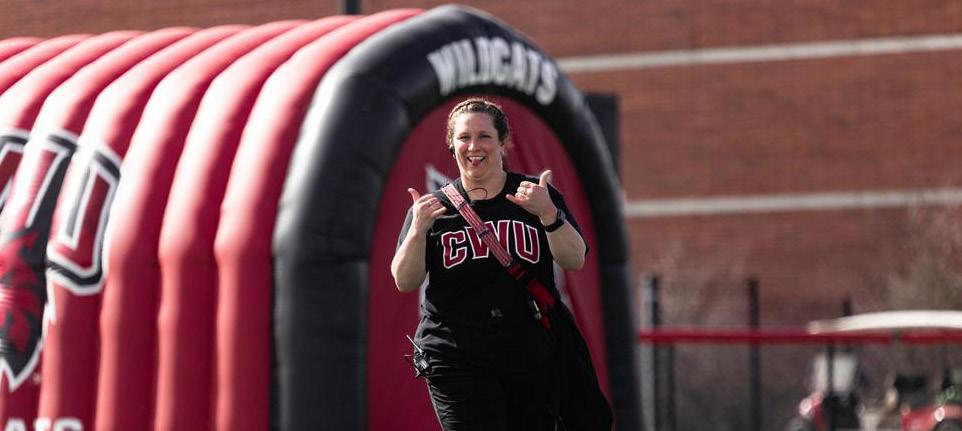
Maggie McBroom Staff Reporter
While going into her second year of athletic training at CWU, men’s rugby and women’s soccer Athletic Trainer Janie Kluempers shares the ins and outs of the duties of an athletic trainer. Including the pregame practices and the chaos of treating players on the field as the play continues.
Kluempers schedule is far from light, as she has a very busy training room at almost all times. She arrives at Nicholson Pavilion at 6 a.m. for pre-practice treatment and taping for men’s rugby, then attends their practice. Afterwards, she does post practice treatment for the rugby players while doing pre practice treatment for the soccer players, and then attends their soccer practice. All of this is done while monitoring rehab exercises for individuals on both teams. On estimate, Kluempers treats about 30-35 athletes every day, all the while tracking each individual’s needs for their specific injuries.
When it comes to in-game duties, Kluempers does her best to enter the field when it’s safe, contact with the rugby players is sometimes unavoidable. Kluempers spoke about an experience with another athletic trainer on the field. “She was helping the player, and then I was shielding the player with my body, and a player ran into me, and it wasn’t a full tackle, it just ran into me because he was looking up for the ball and didn’t see us down. But that’s my goal, is to protect the player who was down,” Kluempers said.
The rugby players themselves play a role in protecting downed players and athletic trainers that

are helping them. Kluempers said: “There was one at the BYU game where someone was down and they weren’t in control of themselves. They passed out because of a concussion, and the guys on our team were pretty good about trying to make sure that me and that player were safe, because I had to go out there. He wasn’t safe because he couldn’t control or protect himself. So our guys were trying to move the ball into a different direction.”
Kluempers must assess each unique situation and provide what an injured player needs based on their reactions to high levels of pain. Some players react with anxiety or dread, while others have an unexpected sense of humor.
Kluempers said: “One guy in college, he’s the last line of defense. He got just absolutely trucked, and his hip came out. And I go on, and he’s just like, ‘I’m in so much pain.’ But really, it was almost like he was on ‘The Office,’ because it was a very dry humor. He’s like, ‘I’m in a lot of pain.’ I said, ‘Okay, we’ll call 911,’ just trying to keep him talking and keep him in a safe position. And then the ambulance came, and they’re like, ‘Hey, what’s your pain levels?’ And he’s like, ‘A 10,’ but he was so nonchalant about it. And then they gave him some pain meds on on the field, because they had to transport him but his hip’s out of place. And after they gave him the meds, they’re like, ‘How’s your pain?’ And he was, like, ‘A 6’ and you know, just super chill about it.”
Some people, on the other hand, are completely unresponsive. The lack of helmets combined with the fast pace and full contact can make for some very
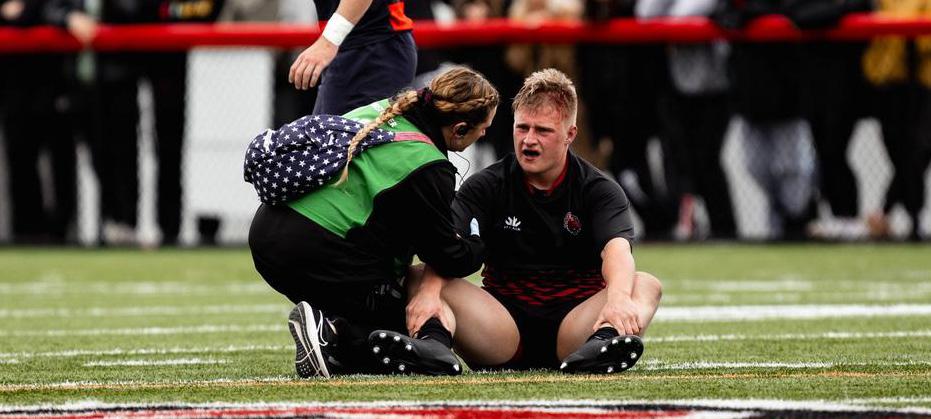

severe concussions. One of the heavier parts of Kluemper’s job is treating players who start to seize. In the moment, there is not much that you can do to treat them except to protect their head and wait for the seizure to pass. “I’ve seen a lot of those, and that’s kind of happened in my hands. Those are things that don’t leave you,” Kluempers said. While it is hard work, Kluempers has a lot of appreciation for it. According to Kluempers, her favorite part is “Getting to know the person, and not just the athlete, because I do get to see you guys day in and day out, and then to turn around and see them on the field be successful in whatever respective sport they’re in.”
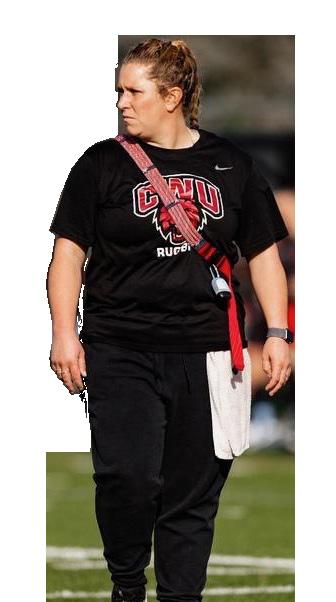


Astor Powell-Pedersen News Editor
With the US presidential elections less dates Democrat Kamala Harris and tance. The Observer chose these topics Generation Z. All information is taken
The Harris campaign website focuses on the smuggling of drugs and guns, and human trafficking across the U.S.-Mexican border. Harris said she plans to bring back a bipartisan bill that was killed under the Trump administration that “would have deployed more detection technology to intercept fentanyl and other drugs and added 1,500 border security agents to protect our border,” and sign it into law. “At the same time, she knows that our immigration system is broken and needs comprehensive reform that includes strong border security and an earned pathway to citizenship.”
Harris’s website states that under her presidency, she would fight for affordable, high quality childcare and preschool, strengthen public education and training and “continue working to end the unreasonable burden of student loan debt and fight to make higher education more affordable, so that college can be a ticket to the middle class.”
Harris is running on a campaign of boosting middle class families. She plans to do this by making house ownership more affordable by providing up to $25,000 for first time buyers to help with a downpayment, cutting taxes for middle class families, bringing down the cost of healthcare and childcare, supporting American innovation, workers and small businesses and lowering energy costs.
Harris’s website says, “Vice President Harris and Governor Walz trust women to make decisions about their own bodies, and not have the government tell them what to do,” she said she will not allow the federal government to pass a nationwide abortion-ban.
The Harris campaign page does not list policy on transgender issues.
less than a month away, it’s vital to know where candiRepublican Donald Trump stand on topics of importopics as we believe they are of the most importance to taken from candidate websites.
Chapter two of the official platform document for the Trump campaign, “2024 GOP Platform Make America Great Again,” lists six ways in which the Trump administration plans to handle immigration. These plans include building a border wall, invoking stronger laws on immigration such as bringing back Trump-era travel bans, and the largest deportation in American history. “Republicans will use existing Federal Law to keep foreign Christian-hating Communists, Marxists, and Socialists out of America. Those who join our Country must love our Country,” The document also states that they will use extreme vetting to keep out muslims and those who allegedly sympathize with an Islamic state, using what is commonly considered to be an Islamaphobic slur. He also puts a focus on putting American workers first.
Trump’s GOP platform document states that the Trump administration will better K-12 education by ending teacher tenure and adopting Merit pay, supporting homeschooling families, pushing for project-based learning, advocating for immediate suspension of any violent child, enforcing parental rights, ensuring “children are taught fundamentals like Reading, History, Science, and Math, not Leftwing propaganda,” promoting love of one’s country by reinstating “the 1776 Commission, promote Fair and Patriotic Civics Education, and veto efforts to nationalize Civics Education,” enforcing the right to read the bible and pray in class and returning the control of education to the states.
The Trump campaign plans to “Build the greatest economy in history,” according to chapter seven of their campaign plan document. To do this, Trump plans to cut regulations that “stifle jobs,” make Trump tax cuts permanent and stop taxes for tips, make fair trade deals, focus on low-cost energy such as oil, natural gas and coal, defend the right to mine crypto, “repeal Joe Biden’s dangerous Executive Order that hinders AI Innovation,” and have the United States create “a robust Manufacturing Industry in Near Earth Orbit, send American Astronauts back to the Moon, and onward to Mars, and enhance partnerships with the rapidly expanding Commercial Space sector to revolutionize our ability to access, live in, and develop assets in Space.”
The Trump administration will oppose late-term abortion, and support policies that care for mothers, prenatal care and IVF.
The Trump administration will oppose late-term abortion, and support policies that care for mothers, prenatal care and IVF.

Sharing perspectives

Supporting awareness
Kam Schindewolf-Broyles Staff Reporter
Mabuhay is alive and well here at CWU, and it lives through our Filipino American students. Mabuhay is a Filipino greeting directly translated from Tagalog to mean, “long live!” or used as a way to cheers in Filipino culture. The month of October observes Filipino American History Month (FAHM), a celebration that is very important to the Filipino American (FilAm) community. The first recorded presence of Filipinos in the United States was on October 18, 1587, when they landed in Morro Bay, California. They were referred to as, “Luzones Inidos,” directly translating to the Luzon Indians, named after the largest island in the Philippines. As the years went on Filipino Americans helped to build America into what it is today.
Filipino American History Month, originally named Filipino American Heritage Month, was first proposed in 1992 by Dr. Fred Cordova and his wife, Filipino American National Historical Society (FANHS) founder, Dr. Dorothy Laigo Cordova. The first celebration of this month took place in 1992, and was officially recognized by congress in 2009. But why was it changed to history and no longer heritage?

“We call it Filipino American History Month because it’s larger than just simply cultures, larger than simply our traditions…” CWU FASA President Ralph Ramier said, “ We want to emphasize our importance in the country of America and how we have literally built our community as a one people, as Filipinos.” While wanting to be recognized for their rich culture, they also want to be recognized for their position in the United States as well.
So, what does FAHM mean to Filipino Americans here at CWU? Ramier said, “For me… it means that we as Filipino people are recognized, celebrated and we show gratitude to each other. The Filipino American community is a very strong community. It’s one that is very unique in the aspect of collaboration, supporting each other during this month. It’s very special to me.” CWU FASA Vice President Jaden Joy Rosabia adds on, “My family was able to immigrate here and really make a living for themselves… we’re very grateful and very lucky to be able to make a living here in the United States, especially [coming from] the Philippines where it’s kind of hard to really make a living for yourself out there”.
But what makes the experience of the FilAm community different from those of the Filipi -
nos actually living in the Philippines? Are they able to connect with their culture while being so far away from their homeland? Rosabia says, “people in the Philippines claim that Filipino Americans… aren’t actually Filipino. Very interesting because our blood is Filipino… I grew up very close to the culture but not as close as I wish.” She adds on, “I think we have a harder time trying to figure out our identity and our culture just because there’s so many cultures out there [in the United States] which we’re very grateful for… but also at the end of the day there’s your culture too”.
At the end of every FASA meeting the group ends with Isang Bagsak, a Tagalog term coined in the 60s from the United Farm Workers Movement. The phrase translates to “one fall,” with the participants starting with a slow clap, gradually getting faster until someone calls out, “Isang Bagsak!” and everyone ends in one large clap together. This signifies the community that the FilAm people feel with one another. That if they fall, they fall together, and if they rise they will rise together even stronger.




Brandon Mattesich Columnist
Welcome back to Sound Bite! This week we have a couple major releases, an update to some long-running rap beef and a couple standouts that deserve a shout!
GloRilla just released her latest album “GLORIOUS” after her recent more mainstream success. From performing at the Grammys, to having chart topping hits with the likes of Megan Thee Stallion, it’s no surprise that her newest album is being met with such a wide reception.

Isaac Hinson Columnist ike_
It’s my favorite time of the year for movie watching – Halloween. Well, it isn’t Halloween yet, not quite. But we are only a few weeks away. The weather is getting colder, the clothes are getting warmer and every streaming service is loading up on horror movies. Here is a glimpse into what I’ve already watched or what I’ll be tuning into, and why you should do the same.
“Fright Night” (1986)
Available on Max
It’s been a long time since I’ve watched a movie and immediately knew it was going to be a favorite of mine for the rest of my life, but that happened when I watched the classic vampire erotic-horror-thriller “Fright Night” at the beginning of this month.
The best part about “Fright Night” is that it was simply better than it needed to be. I would’ve been happy if the movie had ended and I had been sufficiently entertained and decently scared, but “Fright Night” has so much more to give than that.
The movie is supremely entertaining and incredibly scary at the same time, which is largely due to the two lead performances from William Ragsdale as the film’s protagonist Charley Brewster and especially Chris Sarandon as the vampire villain Jerry Dandrige. Sarandon is impossibly charismatic while seducing every member of Charley’s life, and then on the flipside can be overpowering and terrifying when he lets his true vampire side show.
“Hellraiser” (1987)
Available on Prime Video
For years I have scrolled past the “Hellraiser” poster while trying to find some-
thing to watch, and for years I have always thought “Maybe next time.” Well, next time came this past weekend for me, and I was totally blown away.
“Hellraiser” is not what you might think it is, which is ever for the better. It’s a much slower, methodical movie than its peers in the 80s horror pantheon –like “Friday the 13th” or “A Nightmare on Elm Street” – which builds to a truly thrilling final act where the interpersonal family dynamics become injected with psychosexual horror and then get some Cenobites sprinkled on top. The Cenobites themselves aren’t in the movie for that long, which was a shock to me but not necessarily a bother because there is still body-horror galore in the hour leading up to their arrival thanks to some – like “Fright Night” –really exceptional practical effects work on one of the main characters.
“The First Omen” (2024) Available on Hulu
For my money, the best horror movie of the calendar year. I saw “The First Omen” in theaters earlier this year and plan to revisit it this month. A prequel to a good-not-great 70s horror landmark, “The First Omen” reinvigorated not only “The Omen” franchise but also religious horror in the mainstream mere weeks before another film I quite enjoy “Immaculate” debuted.
Bookmarked by one of the best opening scenes in a horror movie and one of the most horrifying final acts as well, this movie is carried on its shoulders and absolutely would not work without lead actress Nell Tiger Free’s complete commitment to her role, and director Arkasha Stevenson’s poise and maturity in her directorial feature debut. Though it does have a lot of similar beats to its original predecessor, I feel like

“The First Omen” wears its influences on its sleeve in a way that is endearing and additive, rather than vapid and distracting. Beyond the original film, “The First Omen” also draws from films like “Possession,” “The Exorcist” and…
“Saint Maud” (2020) Available on Prime Video
Potentially the most plainly despairing movie of the last ten years, “Saint Maud” has been on my mind since I saw it. The final shot particularly, the final second even, has been burned into my brain.
The movie lives and dies by Rose Glass’ supreme direction and Morfydd Clark’s excellent lead performance. In her directorial debut, Glass creates a world that doesn’t appear to be worth saving, worth preaching to or worth praying for. The streets are dark and rainy and the people are gross and predatory, Maud possibly the worst of all.
As an ex-church-goer, religious horror is something I have always been drawn to. I just talked about “The First Omen,” I wrote about “Immaculate” at length last year, and “The Exorcist” is one of my all-time favorite movies. “Saint Maud” is kind of in its own lane, offering a film focused purely on the internal – and subliminally external – horror that the titular Maud is going through. If there was one movie I’ve talked about here today that you check out this Halloween season, I would hope that it is “Saint Maud.”
Personally, I really liked the project. It’s loud, it’s aggressive and it utilizes GloRillas extremely unique vocals very well. I think we are reaching a turning point in hip hop where women are finally starting to crack through to the mainstream, and not just to female audiences. GloRilla’s incredibly blunt, harsh and fun music is a testament to that fact. Just a few years ago this type of music would never have made it so far.
J. Cole made headlines again after dropping his latest song “Port Antonio” which addresses not only his future, but his thoughts on the longstanding Drake and Kendrick Lamar beef. For those who might not remember, J. Cole had a very rough start to the beef, releasing his own diss and then taking it down almost immediately. The backlash was immense, and it feels like ever since then he’s been trying hard to get back to where he was before. This song is a turning point, it shows that he still has it, he still knows what he’s doing and his future in music is no longer in doubt.
BigXthaPlug also released a new album entitled “TAKE CARE.” A surprisingly consistent and well put together album that is not only able to maintain the funny and unique spin BigXthaPlug has on the rap scene, but actually goes a good bit deeper than any of his music has in the past. It’s by no means an introspective masterpiece, but if you’re a fan of his music I would definitely recommend it.
And lastly, a bit of unconventional music news, we’re going to cover an upcoming movie release! By the time you are reading this, the Pharrell Williams biopic “Piece by Piece” will have been released. The film is set entirely in a Lego universe, covering Williams upbringing and some history behind a lot of his most iconic songs.
From Snoop Dogg to Despicable Me, Williams has played a crucial part in so many of the most iconic cultural moments of the past few decades. The film is important on a variety of levels, but most importantly it’s just his story being told. The Lego setting, the PG rating and the musical nature all lend the film to be an incredibly inspiring piece for the next generation of music producers.



Photos by Trent Meacham







Send us your own pumpkins on Instagram to be featured in our Halloween issue!

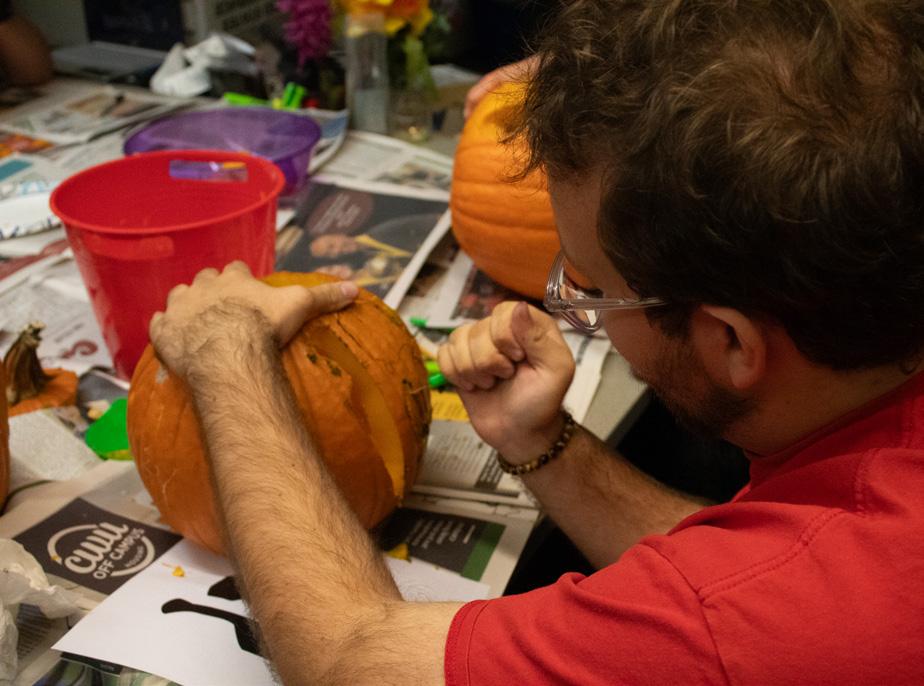
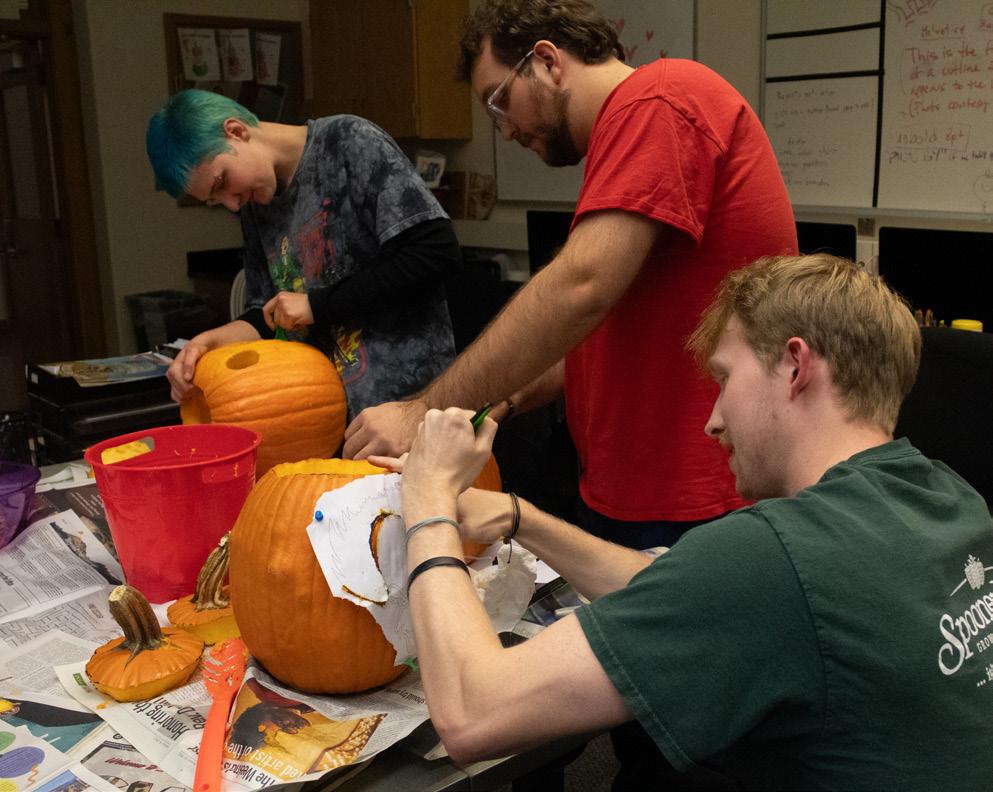

Kaylee Zimmerman Jr. Elementary Education

“Jennifer from ‘Jennifer’s


“Billy Loomis and Stu Macher from ‘Scream.’”













Compiled
by Lee
Beck Design by Z Morris
Aries (March 21 - April 19): Faith, trust and pixie dust. That’s how you’ll see a ram fly. But also, Peter Pan isn’t knocking on your window soooo… I dunno how you’ll do it but you totally will.
Taurus (April 20 - May 20): Hi Taurus :) NOTHING IS CERTAIN! THE WORLD IS ENDING! THERE’S WISHY-WASHY’S IN THE GOVERNMENT! BUY GOLD! Or don’t.
Gemini (May 21 - June 20): Focus on the little things. But also sometimes the little things are the big things. But the big things can’t be focused on right now. So just the little things.
Cancer (June 21 - July 22): It’s just one of those days, where you don’t wanna wake up. Bizkit knows what’s up with you, Cancer, but breaking stuff isn’t necessarily allowed so sadly everything just might be fucked.
Leo (July 23 - Aug. 22): Really gonna show up for the Biology nurture vs nature crowd, because the stars are saying nutrition is necessary. Also, I know for a fact that trees get nutrients from the sun, so like same goes for us.
Virgo (Aug. 23 - Sep. 22): Don’t miss the forest looking at the trees, and don’t miss the hive looking at the bees, Virgo. There’s honey in that there tree, and if you get stung… YOU GET STUNG! GET THAT HONEY!
Libra (Sep. 23 - Oct. 22): Life is full of ups and downs. Sometimes loopty-loops. Sometimes there’s tunnels. If it’s fancy, you get your picture taken at the end. It’s a rollercoaster… OF LOOOVVVEEE!
Scorpio (Oct. 23 - Nov. 21): A Romeo and Juliet-esque love story is about to unfold in your direction, but instead of the classic, Shakespearian ending you both simultaneously find out who the other is voting for in this upcoming election.
Sagittarius (Nov. 22 - Dec. 21): Life’s so hard :/ but bed and blanket and pillow are soft. Life’s hard but grass is soft :) Life is so incredibly hard but pajamas are so so soft. What I’m saying is you should take a really nice cozy nap.
Capricorn (Dec. 22 - Jan.19): Omg 0#_#0 So I literally just heard from Rebecca’s brother’s psychic that there’s a for-serials-friends-to-lovers-sitch coming your way. And I’d definitely trust him, because Tom’s got a knack for predicting stuff like that.
Aquarius (Jan. 20 - Feb.18): Soooo, not to alarm you but have you ever seen “Monster House”? It’s gonna happen to you, but she’s gonna be like a really cool monster house. And fun to talk to. And loves your friends. And makes a really great cream pie.
Pisces (Feb. 19 - March 20): Like George Micheal’s 1987 masterpiece, you gotta have faith, faith, faith. But, you just wait for something more. Listen to Mr. Micheal.




3





